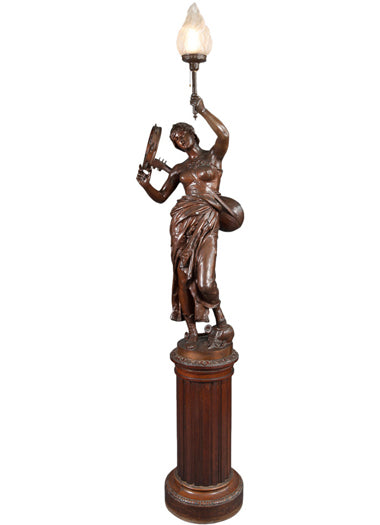A LARGE FRENCH PATINATED BRONZE SCULPTURE DEPICTING 'MUSIC' BY JULES-FELIX COUTAN
By Jules Felix Coutan (French, 1848-1939)
$65,000.00
The detailed description depicts a remarkable life-size patinated bronze figural torchere, sculpted to portray a classically clad female musician holding a mandolin and a torch. This exquisite piece symbolizes Music and aligns with Coutan's allegorical repertoire, showcasing his artistic mastery and thematic exploration.
The sculpture, created by Coutan and cast by Thiébaut Frères, showcases the harmonious blend of classical themes and artistic representation. Coutan, known for his allegorical works, captures the essence of Music through the poised figure of the female musician, adorned with a mandolin, a classical musical instrument, and a torch, signifying illumination and enlightenment through music.
The sculpture's life-size proportions add to its commanding presence and artistic significance. Mounted on a period carved wood pedestal, it stands as a focal point, radiating both artistic beauty and thematic depth.
The inscription on the base, bearing Coutan's name along with Thiébaut Frères, emphasizes its authenticity and the collaboration between the sculptor and the foundry.
Overall, this life-size patinated bronze torchere by Coutan is not only an exquisite representation of Music but also a testament to the craftsmanship and artistry of the sculptor, making it a captivating and valuable addition to any discerning art collection.
Total Height: 101″ (259 cm)
Bronze height: 67″ (170.1 cm)
Pedestal Height: 34" (86.3 cm)
Jules-Félix Coutan (22 September 1848 – 23 February 1939) is considered to be one of the most gifted French sculptors and designers of the 19th and early 20th centuries
Coutan studied under the renowned Pierre-Jules Cavelier at the Ecole des Beaux-Arts in Paris, and was awarded the Prix de Rome in 1872; after his return to Paris he executed the fountain group France Bearing the Torch of Civilization for the Exposition Universelle (1889), one of the two prominent sculptural commissions for the Exposition grounds.[1] Later he taught at the École des Beaux-Arts from 1900, where he expressed his disdain for the researches of Rodin— fumiste—[2] and the Impressionist sculptors who followed him. Coutan was elected to the Académie des Beaux-Arts in 1905.[3]
Coutan is best known in the United States for the sculptural group above the entrance to Grand Central Terminal in New York City. For Grand Central Terminal, Coutan was contracted to provide a quarter-size scale plaster model of the three-figure allegorical Transportation group, which he developed from 1911 through 1914. The carving was performed by the William Bradley & Son of Long Island City.[4]
Among Coutan's students were Hippolyte Lefèbvre, Raymond Delamarre, and the Argentine sculptor Rogelio Yrurtia.A fine classical bronze torchiere depicting music by Jules Felix Coutan, on a carved wood pedestal.
The Thiébaut Foundry (1844-1901) was one of the most important foundries of the Nineteenth Century casting monumental works such as the Gloria Victis by Mercie and the monument to the Defense de Paris by Barrias. The foundry was started by Charles Cyprien Thiébaut (1769-1830) and later passed on to his son, Charles Antoine Floréal (born 1794), who established the business on Rue du Faubourg-Saint-Denis under the name Theibaut St. In 1870, Victor Thiébaut left his enterprise to his three sons, who established the name Thiébaut Frères. The Foundry participated in a number of International Exhibitions and was to acquire an important international reputation.



















